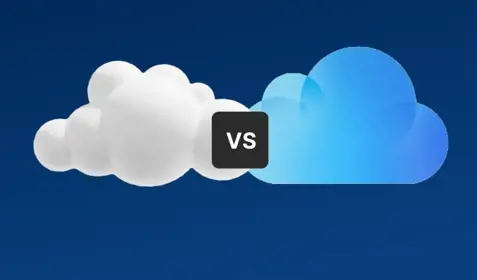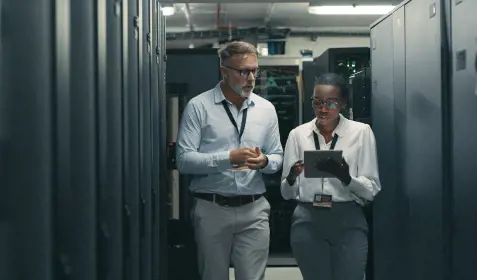According to a Frost & Sullivan survey about cloud infrastructure and service usage, 48% of respondents said that “implementing resiliency or backup plans for apps and data” was a crucial or very important challenge. In the same survey, 54% said that they’re moving apps and data among different cloud environments to help ensure resiliency.
Cyber resiliency is more important than ever, thanks to a rise in ransomware attacks and the threats of natural disasters.
But managing multiple secondary environments can be a drain on IT resources and as complexity rises, it’s more likely that not all of your infrastructure is getting protected.
Disaster recovery as a service takes the management and overhead of disaster recovery off your hands, while ensuring your data and applications are backed up and can be recovered quickly.
What is Disaster Recovery as a Service?
Disaster recovery as a service (DRaaS) is when a vendor provides everything an organization needs for DR, including DR software, infrastructure, and management. Through this service, DRaaS providers can take most of the costs – both monetary and administrative – out of customers' hands.
DRaaS solutions use software to replicate workloads, data, and user settings to a provider’s cloud. In the event of a disaster, data and applications housed in that cloud are spun up as a secondary production site and remain operational until the customer’s primary site resumes operations and failback can occur. It typically provides faster recovery points and times than other modes of backup and recovery.
What to look for in a DRaaS provider
Not all DRaaS providers offer the same service or options, so customers should look for a provider that fits their specific needs. A good DRaaS solution strikes the right balance between lifting the management burden off of the client and allowing the client to maintain control over their data.
When doing your research, look for these hallmarks of a good DRaaS solution:
- Simple and predictable billing:
Instead of separate bills for the various costs of running a secondary data center or cloud storage provider, companies pay a single subscription with the DRaaS provider. The DR software licenses are also included in the service package.
- Low barrier of entry:
A DRaaS solution provides all the necessary software and infrastructure for DR as a package deal. Organizations don't have to invest in a secondary data center, determine the number of DR software licenses to buy, or have hardware or a cloud target to install the software on.
- Ease of management and maintenance:
The "service" portion of DRaaS includes day-to-day DR management and maintenance so customers devote very little of their own IT resources to keeping up their DR. The DRaaS provider handles everything that ensures the DR system can smoothly execute a failover when disaster strikes.
- Scalability:
Since DRaaS includes infrastructure, software, and maintenance, customers don't have to buy more cloud instances, install more servers, purchase more software licenses, or hire more staff when their DR needs grow. As exponential data growth is guaranteed in the IT world, businesses will inevitably need to scale.
- An extra layer of security:
With DRaaS, a customer's DR environment is far removed from their datacenter, making it harder for malicious actors to compromise it. Even if an attacker has infiltrated an organization's systems, a DRaaS provider will require multiple forms of authorization and verification before allowing anyone to access the DR control plane or perform mass deletions.
The elements of a good backup and recovery plan
In the response layer of your cyber resilience strategy, DRaaS takes care of the backup and recovery of your data and applications as well as many of the administrative tasks necessary for business continuity. But a comprehensive backup and recovery plan is something that your organization and DRaaS provider will work together to fulfill.
When building your backup and recovery plan, make sure these elements are included:
- An emergency response plan
This plan should outline what employees should do to prevent the loss of assets, inventory, and other property in the moments after disaster strikes. There should be a protocol of who to contact and in what order, including the authorities, yourself, and your security team. Make sure each employee understands their duties.
- A business continuity plan
Resuming operations as soon as possible following a disaster is essential. A business continuity plan typically includes a business impact analysis and recovery strategies for your data, which will be fulfilled by DRaaS.
- Insurance coverage
Insurance coverage is a must for any company, but not every kind of business insurance will be helpful in the event of a disaster. Review your current policy and ensure there are no gaps in coverage that could prevent you from collecting.
- Essential supplies
These are the items you, your employees, and your business need in the moments immediately following a disaster. Make emergency supply kits that include bottled water, first aid, cash and device chargers. You may also want backup systems that can get your business up and running immediately, like a secondary source of power or communications system.
- A client communications strategy
You need a plan for communicating with customers and clients about the state of your business after a disaster. This should include phone calls, emails, and social media posts. There should be backup supplier options for your clients if necessary.
- Duplicate and backup records and data
You should have up-to-date duplicates of all your important records, contracts, and documents, and keep them off-site in a safe deposit box or secured in the cloud. DRaaS providers like Carbonite, an OpenText Cybersecurity brand, keep data safe from natural disasters as well as cyberattacks or hardware failure – by providing secure, continuous backup and rapid data restoration onsite and via the cloud with white-glove service and SLAs included.
- Regular, non-disruptive testing
DR should be tested quarterly or more often for critical applications, and tests should be performed whenever a system has had a major software update or application deployment. Testing is important because it reveals any shortcomings of the DR process and provides an opportunity to address them before a disaster occurs. Traditional DR testing can be time-consuming and disruptive, but DRaaS can test failover and recoverability in the background without disruption or consuming organizations' administrative bandwidth.
Visit our DRaaS page to learn more about how to get started.








